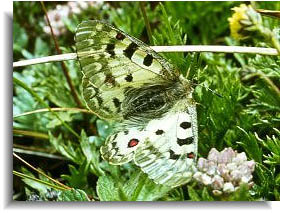 As was revealed, genetic polymorphism in
Parnassius bremeri orotschonicus is comparable to
variability in interspecific hybrids between P. bremeri and
P. nomion. This corresponds with the hypothesis about origin of
P. b. orotschonicus in result of hybridization between P.
bremeri and P. phoebus
(Kurentsov, 1970).
As was revealed, genetic polymorphism in
Parnassius bremeri orotschonicus is comparable to
variability in interspecific hybrids between P. bremeri and
P. nomion. This corresponds with the hypothesis about origin of
P. b. orotschonicus in result of hybridization between P.
bremeri and P. phoebus
(Kurentsov, 1970).
Up to this moment, the question on interaction of P. bremeri and P. phoebus ranges is debated. The most interesting thing is that several subspecies of P. bremeri possess some morphological similarity to P. phoebus from close geographic localities. These data were approved by discriminant analysis of morphological characters (Glushchenko, Martynenko, 2000).
My preliminary data on genetic variability in several subspecies of P. bremeri and nominative subspecies of P. phoebus revealed that P. b. orotschonicus is the most close subspecies to P. phoebus.
More data must be obtained to solve this problem. Study of genetic diversity in most of the known subspecies of these two species is required with this aim. Study of phylogeography in P. bremeri and P. phoebus may give interesting data on interaction between close species. This study will also give a possibility to estimate evolutionary role of interspecific hybridization.
References
Glushchenko Yu. N., Martynenko A.B. (2000) Ecological and geographic variability in parnassians of bremeri-phoebus species group in Zabaikal'e and the southern Far East of Russia. A.I. Kurentsov's memorial meetings. Vol. XI. Vladivostok. P. 63-96. [In Russian]
Kurentsov A.I. (1970) The butterflies of the Far East USSR (Key). Leningrad, Nauka. 163 p. [In Russian]